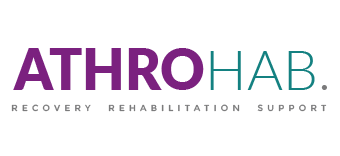The Brace Guide from Athrohab – Part 6
Selected conditions of the knee joint that can benefit from a brace
Osteoarthritis
The surfaces of the knee joint are covered with smooth and hard cartilage. The cartilage provides shock absorption and allows the joint to glide easier.
The composition of the cartilage may change over time which can cause damage to the joint surfaces. This leads to problems with pain, swelling and instability.
Possible causes:
- Hereditary factors.
- Obesity, which loads the knee joint extensively.
- Previous injury to the meniscus or the ligaments of the knee joint.
- Previous fractures or trauma in the knee joint.
Symptoms:
- Pain when overloading the knee joint.
- Pain after periods of inactivity. This can affect sleep patterns.
- Swelling over the knee joint.
- The joint feels stiff especially in the morning.
Suggested actions:
- Active rest. An osteoarthritic knee will feel better when you keep it active.
- Unload the knee joint when you have pain.
- A physiotherapist can design an exercise program where the knee joint is strengthened without much loading.
- A knee brace provides support, relief and heat.
- Physical therapy for pain free exercise and to strengthen the muscles around the knee joint.
Meniscus Injury
The meniscuses are two crescent-shaped cartilage elements on the joint surface between the lower leg and femur. They have many important functions in the knee joint, working as shock absorbing elements but are also crucial to knee stability.
In the past it was common that a damaged meniscus was removed completely, however it was shown that this leads to early osteoarthritis and other knee problems later in life. Today we try to save as much of the damaged meniscus as possible.
Possible causes:
- Turning or twisting of the knee with the foot fixed on the ground. It’s a common injury in football, and handball.
- Inward rotation of the knee often damages the medial meniscus while outward rotation damages the lateral meniscus.
- Hyper-extension of the knee can also cause damage to the meniscus.
Symptoms:
- Pain during movement and loading of the knee joint, especially in deep flexion or in maximum extension.
- The knee joint locks in certain situations.
- Pain over the joint area.
- Pain during inward or outward rotation of the knee joint.
Suggested actions:
- Unload the knee with crutches in the acute phase. This will help to maintain a normal gait pattern.
- Physical therapy to strengthen the muscles around the knee and to maintain good function.
- A knee brace provides support, heat and unloading.
- Consult an orthopaedic doctor to rule out more serious injuries.
Collateral Ligament Injuries – MCL/LCL Ruptures
The knee joint has ligaments located on both sides. The most common ligament injury is the medial collateral ligament injury. The medial collateral ligament or (MCL) grows together with the medial meniscus. Injuries to the MCL often involve damages to the medial meniscus. Injuries to the lateral collateral ligament (LCL) often occur during outward rotation of the knee in combination with rapid extension.
Possible causes:
- Inward or outward rotation of the knee when the foot is fixed on the ground for example during football or handball.
- A collision causing trauma against the side of the knee.
- Hyper-extension of the knee joint in combination with rotation.
Symptoms:
- Pain directly after the trauma followed by tenderness and swelling over the ligaments.
- Pain that will increase when loading the joint. Severe injuries makes loading of the knee joint impossible.
- General feeling of instability.
Suggested actions:
- Apply a compression bandage over the injured area. Unload the knee joint in the acute phase with crutches.
- Consult an orthopaedic doctor to rule out more serious injuries and fractures.
- Physiotherapy to strengthen the muscles around the knee joint along with an individual training program.
- A knee brace provides support and unloading.
Runners Knee – Iliotibialband Syndrome
Runners Knee is a painful condition on the outside of the knee joint that mostly affects runners. The condition results from running over terrain or uphill with overpronated feet. If the Iliotibial Band and the muscles on the outside are too tight, the area above the insertion on the lower leg will be pulled over the condyle of the thigh bone. This will cause an irritation that can develop into an inflammation. The pain is often distinct and once it starts will make running almost impossible. If you rest, the pain will be reduced but will come back when you start running again.
Possible causes:
- Overloading in combination with poor stretching of the thigh, hip and buttock muscles.
- Strong pronation (inward rotation of the foot) and worn-out running shoes.
Symptoms:
- The pain is distinct and localized on the outside of the knee, 1-2 inches above the knee joint, often just above the condyle of the thigh bone.
- When loading the knee, the pain will increase until it is impossible to continue to run.
- Running on hills, over terrain or stair walking can provoke the symptoms.
Suggested actions:
- Rest until pain-free. Find other activities for a few weeks that don´t give you pain, such as cycling or swimming.
- Stretching of the muscles in the hip, thigh and buttocks can reduce the pain.
- Physiotherapy to strengthen the leg and pelvic muscles.
- Gait analysis to verify that you have appropriate shoes. If any deformities are found, correct with temporary wedges or biomechanically stabilized insoles.
- A knee brace provides heat and pain relief.




